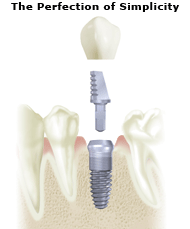What are, actually, dental implants?
Every tooth consists of crown and root/roots. A dental implant is an artificial replacement for the root portion of your natural tooth and is anchored into a pre-drilled socket in your jaw-bone to support a crown, bridge or secure a denture firmly in place. Implants are made of titanium, a material that is well tolerated by the bone and integrates easily with bone tissue. During the placement of a dental implant, the goal is to achieve a close contact between the outer surface of the implant and the surrounding bone tissue so they can “fuse” together (osseointegration), creating a stable support for the new teeth. The whole procedure is performed in operating room, with a local anaesthesia and it takes almost the same time as an extraction of a tooth, and its 100% painless. Dental implants have a lot of advantages over dentures and bridges, like reduced bone loss, improved function, no need to drill or remove any healthy tooth structure, better aesthetics, etc. The most important thing about dental implants is maintaining good oral hygiene of the natural teeth and also of the implants themselves , as well as regularly dental check-ups every six months, or twice of year. That will leed to their lifetime use. If the oral hygiene is absent, a dental plaque is formed around the implants, that will turn into a calculus, and eventually will leed to periodontal problems, bone loss and losing of the implants. Also, smoking decreases the life of the dental implant by 10%.
What is the procedure of placing dental implants?
Depending on the possibilities, indications, and the investigation of the mouth and the health of your teeth and gums, x-rays, CBCT scan,etc, it is decided whether to place implants or not. If not,first we have to provide sufficient bone, using artificial bone graft. If yes, a multiple-step procedure is performed. First, under local anaesthesia, a bone exposure is done and the implant is placed. After placement of the implant, a cover screw is put in and the wound is closed with stitches and allowed to heal. In general, implants in the lower jaw need to ossteointegrate/heal about 2-3 months, while implants in the upper jaw need to heal about 3-6 months. In that period, a provisional bridge or denture can be done, in order not to affect normal life of the patient. After healing, in a second surgical procedure, the implant is uncovered, the cover screw is removed and a gingiva former and later an abutment is placed in the implant. Then impressions are taken in order to make the prosthetic teeth (bridge, denture).


